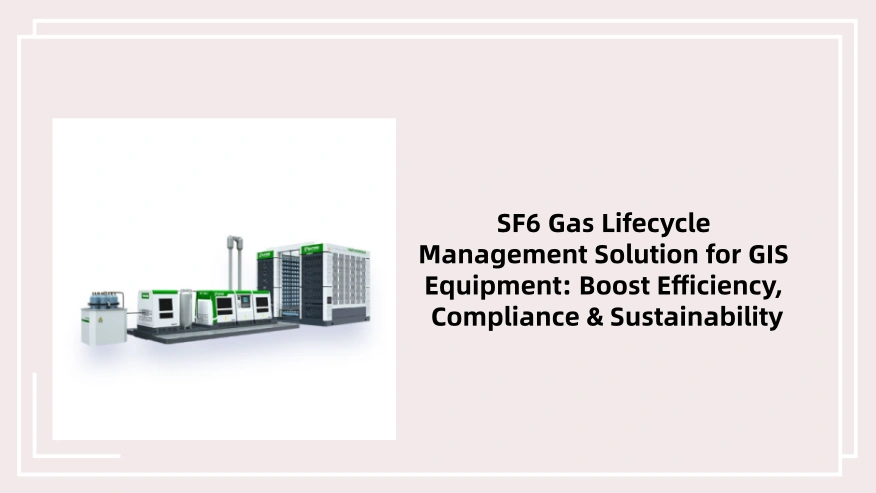
- SF6 Relations
- 2025-10-10
GIS (Gas Insulated Switchgear) is a core device in power transmission and distribution systems, favored for its compact size—ideal for urban substations and space-constrained areas. As the key insulating and arc-quenching medium in GIS, SF6 gas ensures stable operation under high voltage. However, SF6 is a potent greenhouse gas (GWP 23,900 times that of CO₂, with a 3,200-year atmospheric lifespan). Poor management of its lifecycle (procurement, storage, use, recovery, disposal) leads to leaks, resource waste, and compliance risks. Thus, a comprehensive SF6 gas lifecycle management solution for GIS equipment is critical for power enterprises.
1. The Role of SF6 in GIS & Management Pain Points
SF6’s high insulating strength and arc-quenching performance are irreplaceable for GIS, but lifecycle management faces three major challenges:
- Leakage risks: Aging seals or improper installation cause SF6 emissions, harming the environment and reducing GIS insulation efficiency.
- Low recovery efficiency: Traditional recovery equipment has a recovery rate below 90%, wasting SF6 and increasing procurement costs.
- Compliance pressure: Strict regulations (e.g., EU F-Gas Regulation, U.S. EPA standards) mandate SF6 recovery and limit emissions; non-compliance leads to heavy fines.
- Traceability gaps: Lack of full-cycle data records makes it hard to track SF6 flow, causing management chaos.
2. Core Components of an Effective SF6 Lifecycle Solution
A robust solution covers four lifecycle stages, integrating technology and management:
2.1 Procurement & Storage Management
- Source high-purity SF6 (≥99.9% purity) meeting IEC 60376 standards, with suppliers providing quality test reports.
- Store SF6 in sealed steel cylinders in temperature/humidity-controlled areas, avoiding direct sunlight. Inspect cylinder seals and pressure monthly.
- Build a procurement ledger to record batch numbers, purity, and supplier info for traceability.
2.2 Real-Time Monitoring & Leak Control
- Install online SF6 monitoring systems: High-precision sensors track concentration, pressure, and temperature in GIS, transmitting data to a central platform. Alarms trigger for anomalies.
- Use infrared leak detection tools for regular inspections of flanges and valves, locating leaks quickly for repairs.
- Analyze monitoring data to predict seal aging and schedule preventive maintenance.
2.3 Efficient Recovery & Recycling
- Deploy high-efficiency SF6 recovery units (≥99% recovery rate) during GIS maintenance or decommissioning to avoid emissions.
- Purify recovered SF6 via drying, filtration, and purification to remove moisture and decomposition byproducts (e.g., SF4), restoring it to new gas standards for reuse.
- Maintain a recovery-recycling ledger to track volumes, purity, and reuse destinations, forming a closed loop.
2.4 Compliant Disposal
- For non-recyclable SF6 (e.g., heavily contaminated gas), entrust qualified institutions to decompose it via high-temperature cracking into harmless substances (e.g., sulfates).
- Dispose of waste cylinders and seals as hazardous waste per environmental regulations.
3. Key Benefits of Implementation
- Enhanced compliance: Meet global environmental standards, reduce emissions, and avoid fines while improving corporate green credentials.
- Cost savings: Recycling cuts new SF6 procurement costs by 30–50%. Preventive maintenance reduces outage losses from GIS failures.
- Extended GIS lifespan: Pure SF6 avoids corrosion of internal components, extending equipment life by 5–10 years.
- Efficient management: Digital platforms integrate full-cycle data for visual tracking, simplifying audits and decision-making.
4. How to Choose a Solution Provider
- Qualifications: Prioritize providers with ISO 14001 certification and IEC-compliant technologies, and expertise in local regulations.
- Technology strength: Select providers with advanced monitoring (e.g., wireless sensors) and high-efficiency recovery equipment.
- Full-service capability: Opt for providers offering consulting, installation, maintenance, and training to ensure long-term effectiveness.
- Proven track record: Check for successful cases in the power industry (e.g., grid companies reducing leaks by 80% post-implementation).
In the global energy transition, GIS reliability is vital. An SF6 gas lifecycle management solution for GIS equipment not only addresses environmental and compliance challenges but also optimizes costs and operational efficiency. As digitalization advances, such solutions will become more precise, driving the power industry toward greener development.
Recent Post
Categories
- LM-37 Handheld Mixed Insulating Gas Leak Detector
- RF-MG24 SF6 Insulating Gas Mixing and Filling System
- Mobile GIS Clean Maintenance Module
- RFG-1001 Mobile SF6 Gas Service Workstation
- RF-S10 Portable SF6 Recovery Unit
- RF-50H Live-line Gas Purification System
- Distributed • IoT SF6 Management Shelter
- RA912F SF6 Gas Analyzer
- RF-151 SF6 Recovery Unit
- LM-068 Portable SF6 Infrared Leak Detector
Leave a Reply